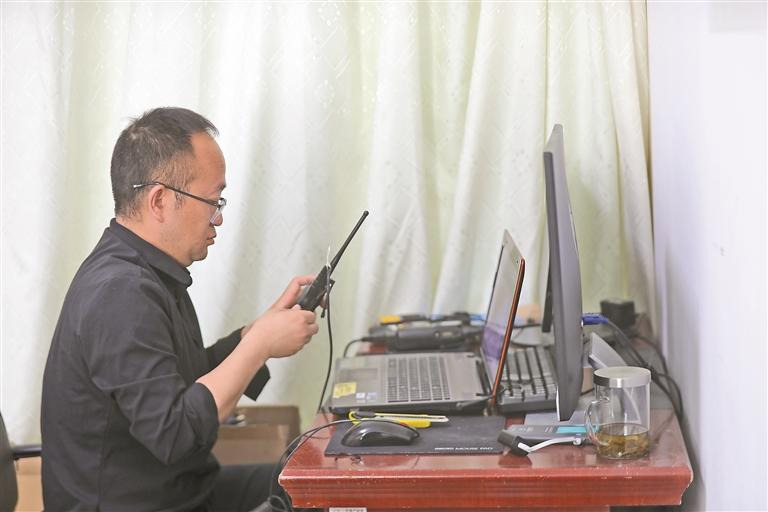Facial, fingerprinting tech locked in a duel

Editor's note: The proliferation of facial recognition technology around the world has not meant the instant demise of fingerprinting for identification purposes. A Shenzhen company is confident that fingerprinting still has a place in the sun and is projected to grow further.

The rapid advent of facial recognition technology worldwide may have created the impression that the art of identifying someone by their fingerprints has turned somewhat obsolete.
With facial recognition technology playing such a ubiquitous role in multiple aspects of our daily lives, such as unlocking smartphones, going through immigration or boarding trains, many companies have stopped turning to fingerprinting in the human identification process.
However, a leading integrated circuit design company in Shenzhen has been sticking to fingerprinting all the way and has emerged as the world's top supplier of in-display fingerprint sensors.
Founded in 2002, Shenzhen Goodix Technology Co started from developing chips for landline telephones and gradually turned itself into a provider of capacitive touch controllers and fingerprint sensors.
Now the company provides its in-display fingerprint technology to Huawei, which was embedded in its new models, Mate 20 Pro and Mate 20 RS Porsche Design, released earlier this week.
Traditionally, capacitive fingerprint sensors are connected to the home button on smartphones as a method of authenticating identity. Global smartphone behemoth Apple Inc had introduced fingerprint recognition technology Touch ID to its smartphones back in 2013.
But, with bezelless smartphone design fast dictating future handset design, manufacturers are seeking solutions to get rid of the home button. Apple, for instance, replaced it with Face ID last year so as to present a "full display".
The problem is that traditional capacitive sensors can't work for in-display recognition. Due to doubts over fingerprint recognition's future and the slowdown in overall smartphone sales, Goodix suffered a 24-percent fall in sales revenue in the first half of this year.
Zhang Fan, chairman and chief executive of Shenzhen Goodix Technology, never stopped seeking possible solutions for in-display fingerprint technology although he admits there has been much pressure in the industry, even from his clients, about its potential.
He was determined to "solve the uncertainty of technology and keep exploring where possibility exists" as he believes this is a necessary process of innovation.
After five years of research, Zhang's team last year unveiled an innovative optical solution to realize in-display fingerprinting. The cutting-edge technology gives smartphone makers an alternative to remove the home button by inserting the fingerprint sensor module under display so that users can press their finger on the screen directly to unlock the phone.
At the same time, the company plowed more than 16 percent of its revenue into research and development, setting up an optical in-display fingerprint R&D team of more than 400 staff.
It began mass production in the first half of this year. Previously, the module was pasted under the screen and the cost of the single action is about $3 each unit, not mentioning wasting expensive OLED screens if it failed, reveals Zhang.
One significant innovation of their mass production solution is to separate the module from the screen so that the difficulties and costs are substantially lowered.
By integrating optical system design, image sensor and algorithm, he's confident that their in-display fingerprint technology is as fast and accurate as the traditional home button.
The false reject rate (falsely rejecting the genuine fingerprint) has been reduced to 2 percent, which is the industry standard, and the unlocking speed shortened from one to 0.35 second.
Zhang predicts that shipments of their optical in-display fingerprint solution could reach 10 million in the second half of this year.
The innovative technology has been adopted by mainstream phone makers in China, such as Huawei, Vivo and Xiaomi.
"I believe multiple biometric authentications can co-exist in one terminal in future but, for now, fingerprinting is the most popular among users, according to our clients' survey," says Zhang.
A growing number of industry players have begun accepting the alternative as more providers, such as US chip giant Qualcomm and Synaptics, have now gone into in-display fingerprint production. The industry is being revived.
According to projection by global information group IHS Markit, shipments of smartphones with in-display fingerprint sensors would reach 100 million units by 2019.
Guo Mingqi, an analyst at TF International Securities, said Android-based smartphone brands have regarded in-display fingerprint sensors as a significant differentiation from iPhones.
He predicted that South Korean tech giant Samsung will start adopting such technology next year.
"Foreign phone makers, such as Apple Inc and Samsung, have always taken the lead in introducing new functions for smartphones, but now, domestic brands have risen to the occasion and won't just follow others anymore," says Zhang.
However, he still keeps a clear head about the technology's limitations. For example, the technology can only work under flexible and rigid OLED screens but not LCD, which is the major choice of low-price phones.
Shenzhen Goodix is working on the issue and expects smartphones costing around 1,000 yuan to have such a new technique next year.
"There's still much potential to be tapped," says Zhang, adding that users may not have to press a fixed spot on the screen for fingerprint authentication, but anywhere on the display in future.
Contact the writer at grace@chinadailyhk.com





































